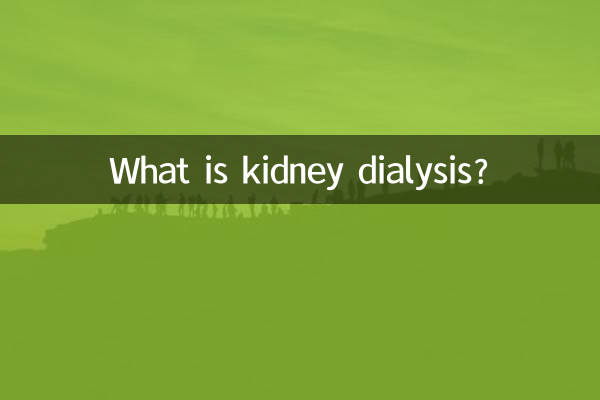What is kidney dialysis?
In recent years, with the increase in patients with chronic kidney disease, kidney dialysis has become a hot topic of public concern. This article will introduce in detail the principles, types, applicable groups and relevant data of kidney dialysis to help everyone better understand this medical technology.
1. Basic principles of renal dialysis

Kidney dialysis is a treatment method that artificially replaces kidney function. It is mainly used to remove metabolic waste and excess water from the blood and maintain electrolyte and acid-base balance. When kidney failure occurs, dialysis becomes an important means for patients to extend their lives.
2. Main types of kidney dialysis
| Type | Principle | Applicable scenarios |
|---|---|---|
| Hemodialysis | The blood is taken out of the body through a dialysis machine, filtered and reinfused | Need to go to the hospital regularly, 2-3 times a week |
| peritoneal dialysis | Using the peritoneum as a natural filter membrane, exchange dialysate through the peritoneal cavity | Can be operated at home, dialysate needs to be changed daily |
3. Who needs kidney dialysis?
Kidney dialysis is usually suitable for the following people:
| Applicable people | Specific instructions |
|---|---|
| chronic renal failure patients | Dialysis is required when the glomerular filtration rate (GFR) is less than 15ml/min |
| patients with acute kidney injury | Renal function declines sharply in a short period of time, requiring temporary dialysis support |
| Drug or poisoning patients | Certain drug overdoses or poisoning require emergency dialysis to remove toxins |
4. Current status and data of renal dialysis
According to the latest statistics:
| Statistics Project | data | Remarks |
|---|---|---|
| Global number of dialysis patients | about 3.5 million people | Growth of 5-8% per year |
| Number of dialysis patients in China | About 800,000 people | 2023 Statistics |
| dialysis treatment cost | An average of 50,000-100,000 yuan per year | Medical insurance can reimburse some expenses |
| patient survival time | Average 5-10 years | closely related to treatment compliance |
5. Precautions for kidney dialysis
Patients receiving kidney dialysis treatment need to pay attention to the following things:
| Things to note | Specific content |
|---|---|
| Diet control | Limit water, sodium, potassium, and phosphorus intake |
| medication management | Take antihypertensive drugs, erythropoietin, etc. on time |
| Vascular access care | Keep arteriovenous fistulas or catheters clean to avoid infection |
| Regular inspection | Monitor blood pressure, blood routine, kidney function and other indicators |
6. Development of kidney dialysis technology
In recent years, kidney dialysis technology has continued to improve, mainly reflected in:
1. Research and development of portable dialysis equipment to improve patients’ quality of life
2. Clinical trials of bioartificial kidneys are expected to achieve more physiological replacement treatments
3. The application of remote monitoring technology allows doctors to adjust treatment plans in real time
7. How to prevent kidney disease?
Prevention is better than cure. To protect kidney health, you need to pay attention to:
1. Control basic diseases such as high blood pressure and diabetes
2. Avoid drug abuse, especially NSAIDs
3. Maintain a healthy diet and reduce high-salt and high-protein intake
4. Regular physical examinations to detect kidney problems early
Although kidney dialysis can prolong life, it brings a lot of inconvenience and economic burden to patients. The fundamental way is to pay more attention to kidney health and prevent the occurrence of kidney disease. If you or your family members have related symptoms, it is recommended to seek medical examination in time. Early intervention can often achieve better treatment results.

check the details

check the details